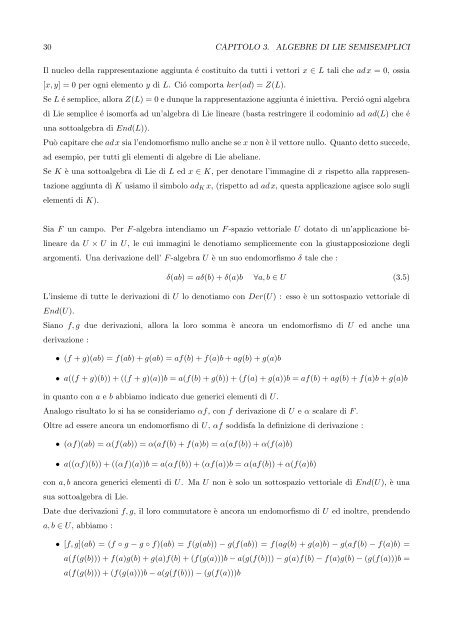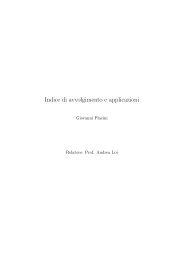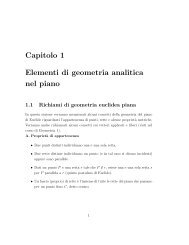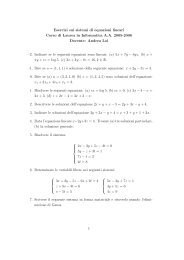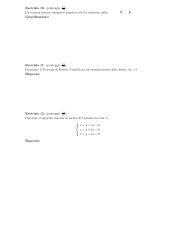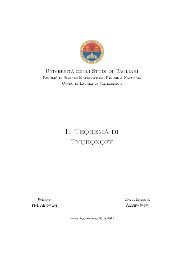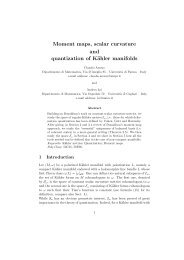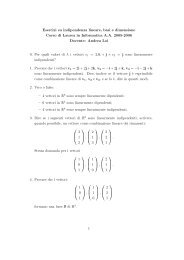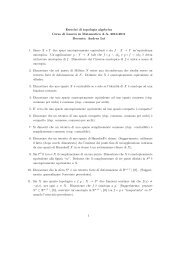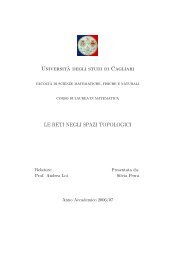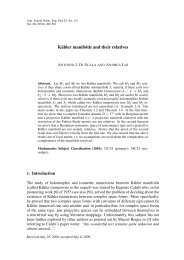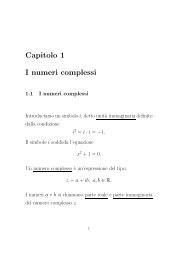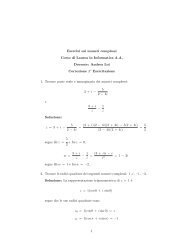Algebre di Lie semisemplici, sistemi di radici e loro classificazione
Algebre di Lie semisemplici, sistemi di radici e loro classificazione
Algebre di Lie semisemplici, sistemi di radici e loro classificazione
You also want an ePaper? Increase the reach of your titles
YUMPU automatically turns print PDFs into web optimized ePapers that Google loves.
30 CAPITOLO 3. ALGEBRE DI LIE SEMISEMPLICI<br />
Il nucleo della rappresentazione aggiunta é costituito da tutti i vettori x ∈ L tali che ad x = 0, ossia<br />
[x, y] = 0 per ogni elemento y <strong>di</strong> L. Ció comporta ker(ad) = Z(L).<br />
Se L é semplice, allora Z(L) = 0 e dunque la rappresentazione aggiunta é iniettiva. Perció ogni algebra<br />
<strong>di</strong> <strong>Lie</strong> semplice é isomorfa ad un’algebra <strong>di</strong> <strong>Lie</strong> lineare (basta restringere il codominio ad ad(L) che é<br />
una sottoalgebra <strong>di</strong> End(L)).<br />
Può capitare che ad x sia l’endomorfismo nullo anche se x non è il vettore nullo. Quanto detto succede,<br />
ad esempio, per tutti gli elementi <strong>di</strong> algebre <strong>di</strong> <strong>Lie</strong> abeliane.<br />
Se K è una sottoalgebra <strong>di</strong> <strong>Lie</strong> <strong>di</strong> L ed x ∈ K, per denotare l’immagine <strong>di</strong> x rispetto alla rappresen-<br />
tazione aggiunta <strong>di</strong> K usiamo il simbolo adK x, (rispetto ad ad x, questa applicazione agisce solo sugli<br />
elementi <strong>di</strong> K).<br />
Sia F un campo. Per F -algebra inten<strong>di</strong>amo un F -spazio vettoriale U dotato <strong>di</strong> un’applicazione bi-<br />
lineare da U × U in U, le cui immagini le denotiamo semplicemente con la giustapposiozione degli<br />
argomenti. Una derivazione dell’ F -algebra U è un suo endomorfismo δ tale che :<br />
δ(ab) = aδ(b) + δ(a)b ∀a, b ∈ U (3.5)<br />
L’insieme <strong>di</strong> tutte le derivazioni <strong>di</strong> U lo denotiamo con Der(U) : esso è un sottospazio vettoriale <strong>di</strong><br />
End(U).<br />
Siano f, g due derivazioni, allora la <strong>loro</strong> somma è ancora un endomorfismo <strong>di</strong> U ed anche una<br />
derivazione :<br />
• (f + g)(ab) = f(ab) + g(ab) = af(b) + f(a)b + ag(b) + g(a)b<br />
• a((f + g)(b)) + ((f + g)(a))b = a(f(b) + g(b)) + (f(a) + g(a))b = af(b) + ag(b) + f(a)b + g(a)b<br />
in quanto con a e b abbiamo in<strong>di</strong>cato due generici elementi <strong>di</strong> U.<br />
Analogo risultato lo si ha se consideriamo αf, con f derivazione <strong>di</strong> U e α scalare <strong>di</strong> F .<br />
Oltre ad essere ancora un endomorfismo <strong>di</strong> U, αf sod<strong>di</strong>sfa la definizione <strong>di</strong> derivazione :<br />
• (αf)(ab) = α(f(ab)) = α(af(b) + f(a)b) = α(af(b)) + α(f(a)b)<br />
• a((αf)(b)) + ((αf)(a))b = a(αf(b)) + (αf(a))b = α(af(b)) + α(f(a)b)<br />
con a, b ancora generici elementi <strong>di</strong> U. Ma U non è solo un sottospazio vettoriale <strong>di</strong> End(U), è una<br />
sua sottoalgebra <strong>di</strong> <strong>Lie</strong>.<br />
Date due derivazioni f, g, il <strong>loro</strong> commutatore è ancora un endomorfismo <strong>di</strong> U ed inoltre, prendendo<br />
a, b ∈ U, abbiamo :<br />
• [f, g](ab) = (f ◦ g − g ◦ f)(ab) = f(g(ab)) − g(f(ab)) = f(ag(b) + g(a)b) − g(af(b) − f(a)b) =<br />
a(f(g(b))) + f(a)g(b) + g(a)f(b) + (f(g(a)))b − a(g(f(b))) − g(a)f(b) − f(a)g(b) − (g(f(a)))b =<br />
a(f(g(b))) + (f(g(a)))b − a(g(f(b))) − (g(f(a)))b


